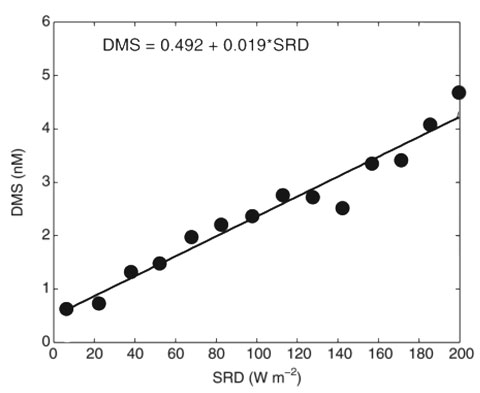Volume 10, Number 6: 7 February 2007
Dimethylsulfide or DMS, in the words of the authors of an important new paper (Vallina and Simo, 2007), "represents the largest natural source of atmospheric sulfur and [is] a major precursor of hygroscopic (i.e., cloud-forming) particles in clean air over the remote oceans, thereby acting to reduce the amount of solar radiation that crosses the atmosphere and is absorbed by the ocean." As such, it is widely acknowledged to be the primary player in a biologically-modulated negative climate feedback mechanism first described two decades ago in the classic paper of Charlson et al. (1987); and evidence continues to mount (see Dimethylsulfide in our Subject Index) that it may well prove the salvation of the planet by significantly muting anthropogenic-augmented CO2-induced global warming.
The phenomenon begins with an initial impetus for warming, such as an increase in the air's CO2 content, which induces an increase in the productivity of marine phytoplankton that results in a greater production of oceanic DMS and its release to the atmosphere, where greater gas-to-particle conversions increase the atmosphere's population of cloud condensation nuclei and, ultimately, the reflection of solar radiation back to space by marine stratus and altostratus clouds via a narrowing of the cloud droplet spectrum and a decrease in the mean radius of the cloud droplets, both of which phenomena counteract the initial impetus for warming and thus complete the negative climate feedback cycle.
In the new study of this subject (published in the 26 January 2007 issue of Science), Sergio Vallina and Rafel Simo of Spain's Institut de Ciencies del Mar describe two observational studies - one conducted during 2003 and 2004 in the Mediterranean Sea and the other conducted over the period 1992 to 1994 in the Sargasso Sea - each of which studies reveals a highly significant positive linear relationship between surface water DMS concentration and upper-mixed-layer solar radiation dose or SRD, the latter of which factors accounts for fully 94% of the variance of monthly DMS concentrations in the Mediterranean Sea and 81% of the variance of monthly DMS concentrations in the Sargasso Sea.
The real payoff, however, came when the two researchers analyzed multi-decadal databases that spanned the entire globe. In the case of DMS, they compiled monthly global maps of its concentration from the Global Surface Seawater Dimethylsulfide Database, which may be found here and includes about 30,000 data points collected from 1972 to 2003; while they used the mixed-layer depth database assembled by de Boyer Montegut et al. (2004) - which was derived from more than 4,000,000 temperature profiles obtained between 1941 and 2002 - to compile monthly global maps of SRD. Then, computing 10° by 20° (latitude by longitude) box mean DMS concentrations and grouping them by intervals of 15 W m-2 of SRD, they obtained the strong positive linear relationship between DMS and SRD for the global open ocean that is depicted in the figure below.
Figure 1. Surface DMS concentration vs. upper-mixed-layer SRD for the global open ocean. Adapted from Vallina and Simo (2007).
In discussing their impressive findings, Vallina and Simo state that "the tight coupling of DMS concentrations to the solar radiation dose," which is the ultimate driver of ocean temperature change, "is a necessary condition for the occurrence of a negative feedback between plankton and climate through the influence of the former on the radiative energy budget," which influence is to reduce the flux of solar radiation incident on the ocean surface and thereby cool it. In addition, since the solar radiation dose of the ocean surface varies strongly with the season of the year, they say their data indicate that "it is at this seasonal scale that the epipelagic ecosystems respond to temporal and latitudinal changes in solar radiation by changing their production of light-attenuating volatile sulfur."
In a final comment that would appear to be designed to make their paper more palatable to the editors of Science - who are staunch supporters of the rising-CO2-as-catastrophe theory - Vallina and Simo say that "whether this feedback will also operate efficiently at the longer time scale of anthropogenic global warming will depend on induced changes in global cloudiness." Fortunately, all indications to date are that it will.
Sherwood, Keith and Craig Idso
References
Charlson, R.J., Lovelock, J.E., Andrea, M.O. and Warren, S.G. 1987. Oceanic phytoplankton, atmospheric sulfur, cloud albedo and climate. Nature 326: 655-661.
de Boyer Montégut C., Madec, G., Fischer, A.S., Lazar, A. and Iudicone, D. 2004. Mixed layer depth over the global ocean: An examination of profile data and a profile-based climatology. Journal of Geophysical Research 109: doi:10.1029/2004JC002378.
Vallina, S.M. and Simo, R. 2007. Strong relationship between DMS and the solar radiation dose over the global surface ocean. Science 315: 506-508.





